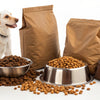Can I Switch My Dog from Raw to Kibble? A Comprehensive Guide for Pet Owners
- Houndsy
Table of Contents
- Introduction
- Understanding the Shift: Why Switch from Raw to Kibble?
- The Transition Process: How to Switch from Raw to Kibble
- Monitoring Health During the Transition
- Benefits of Kibble: Why Choose Houndsy?
- Frequently Asked Questions (FAQs)
- Conclusion
Introduction
Have you ever found yourself questioning the best diet for your furry friend? You're not alone—73% of pet owners feel overwhelmed by the vast array of pet food options available today. For those currently feeding their dogs a raw diet, the thought of switching to kibble can be both daunting and confusing. Whether you're considering this switch due to convenience, cost-effectiveness, or health recommendations from your veterinarian, understanding the intricacies of transitioning your dog from raw food to kibble is essential.
In this blog post, we will explore the reasons behind switching from a raw diet to kibble, the step-by-step process for making this transition, and how to monitor your dog’s health during the change. By the end of this article, you’ll have a comprehensive understanding of the benefits and challenges involved in switching your dog’s diet, along with actionable tips for a smoother transition. We will also highlight how our flagship product, the Houndsy Kibble Dispenser, can enhance the feeding experience, making it both convenient and enjoyable for you and your pet.
Let’s dive into this essential topic for pet owners!
Understanding the Shift: Why Switch from Raw to Kibble?
The decision to switch from raw dog food to kibble can stem from various motivations. Here are some common reasons pet owners consider when making this change:
1. Convenience
Life can get busy, and the time investment required for preparing raw meals can be significant. Kibble offers a quick and easy solution that is simple to store, measure, and serve. With the Houndsy Kibble Dispenser, we can make feeding even more hassle-free by ensuring the perfect portion every time, eliminating the need for messy measuring.
2. Health Recommendations
Veterinarians may recommend switching to kibble for dogs experiencing gastrointestinal issues or other health concerns. A well-balanced kibble diet can be easier for some dogs to digest, especially those who have had prolonged exposure to raw diets.
3. Cost-Effectiveness
Raw dog food can be more expensive than kibble, impacting a pet owner's budget. By switching to kibble, many owners find they can maintain a nutritious diet for their pets while also being mindful of their finances.
4. Nutritional Balance
High-quality kibble is often formulated to meet the nutritional needs of dogs at various life stages. Many brands are available that offer complete and balanced meals, ensuring that your dog receives all necessary vitamins and minerals.
The Transition Process: How to Switch from Raw to Kibble
Transitioning your dog from raw food to kibble should be approached with care to minimize digestive upset. Here’s a step-by-step guide to making the switch:
Step 1: Consult Your Veterinarian
Before making any dietary changes, it’s essential to consult your veterinarian. They can provide personalized advice based on your dog's health history, current condition, and nutritional needs. This is particularly important if your dog has any specific health concerns.
Step 2: Gradual Transition
The key to a successful switch is to transition gradually over a period of 7 to 10 days. Here’s a simple plan to follow:
- Days 1-3: Start by mixing 25% kibble with 75% raw food.
- Days 4-6: Adjust the ratio to 50% raw and 50% kibble.
- Days 7-9: Increase to 25% raw and 75% kibble.
- Day 10: By now, your dog should be ready to eat 100% kibble.
Step 3: Monitor Your Dog’s Response
Keep an eye on your dog during the transition. Watch for any signs of digestive upset, including vomiting or diarrhea. If these occur, slow down the transition process, giving your dog more time to adjust.
Step 4: Hydration Matters
Kibble is less hydrating compared to raw food, so it's crucial to keep your dog well-hydrated during this switch. Ensure your dog has access to fresh water at all times.
Step 5: Evaluate Nutritional Needs
Consider your dog’s individual nutritional needs. If your dog has specific health issues, you may need to choose a specialized kibble that caters to those needs. Always consult your veterinarian if you have concerns about your dog's health during the transition.
Monitoring Health During the Transition
As you transition your dog from raw food to kibble, it's important to monitor their overall health closely. Here are some key factors to keep an eye on:
1. Digestive Health
Watch for changes in your dog’s stool. Healthy dog stools should be firm and moist. If you notice loose stools, it may indicate that the transition is too rapid, and you should revert to the previous feeding ratio temporarily. You can use a Fecal Scoring Chart to help evaluate your dog’s stool consistency.
2. Appetite Changes
Your dog may experience changes in appetite during the transition period. If your dog refuses to eat kibble, try enhancing its appeal with a small amount of warm water, bone broth, or mixing in a little bit of canned food.
3. Behavioral Changes
Keep an eye on your dog's overall behavior. Any significant changes, such as lethargy or excessive thirst, should be discussed with your veterinarian.
4. Allergic Reactions
While rare, some dogs may experience allergic reactions to new ingredients in kibble. Monitor your dog for signs of itching, skin inflammation, or gastrointestinal upset.
Benefits of Kibble: Why Choose Houndsy?
As you consider switching your dog from raw to kibble, it’s essential to choose high-quality kibble that meets your dog’s dietary needs. Here at Houndsy, we are committed to enhancing the feeding experience for both pets and their owners. Our flagship product, the Houndsy Kibble Dispenser, plays a significant role in making this transition smoother:
Ergonomic Design
With an ergonomic crank at a standing height, our dispenser eliminates the need for bending, making it easy and convenient to feed your dog without strain.
Perfect Portion Control
Designed to deliver perfect portions every time, our dispenser ensures that your dog receives the right amount of food without the mess.
Large Storage Capacity
With a storage capacity of 25–30 lbs, our dispenser ensures that you can store enough kibble for your dog, making it an ideal solution for busy pet owners.
BPA-Free Liner
Our BPA-free liner keeps kibble fresh, ensuring that every meal provided is nutritious and appetizing.
Auto-Locking Mechanism
Our auto-locking mechanism prevents accidental dispensing, providing peace of mind for pet parents with curious dogs or children.
If you're considering making the switch, we invite you to explore the Houndsy Kibble Dispenser here.
Frequently Asked Questions (FAQs)
1. Is it safe to switch my dog from raw food to kibble?
Yes, it is safe to switch your dog from raw food to kibble, but it’s important to do so gradually to avoid digestive upset.
2. How long should the transition take?
The transition should ideally take between 7 to 10 days. This gradual approach allows your dog’s digestive system to adapt to the new diet.
3. What signs should I look for during the transition?
Monitor your dog for signs of digestive upset such as vomiting or diarrhea, as well as changes in stool consistency and appetite.
4. Can I mix raw food with kibble during the transition?
While mixing raw food with kibble can be done at the beginning of the transition, it is advisable to keep them separate once you’ve fully transitioned to avoid digestive complications.
5. What if my dog refuses to eat kibble?
If your dog is reluctant to eat kibble, try enhancing its appeal with a small amount of warm water, bone broth, or mixing in a little bit of canned food.
Conclusion
Switching from raw dog food to kibble doesn’t have to be a stressful experience. By following the steps outlined in this guide and utilizing tools like the Houndsy Kibble Dispenser, we can simplify the feeding process, making it more enjoyable for both you and your furry companion. Remember, your dog's health and happiness are our top priority, and we’re here to support you every step of the way!
As you embark on this journey, consider how our innovative design and commitment to quality can enhance your everyday pet care experience. For a convenient and reliable feeding solution, explore the Houndsy Kibble Dispenser today!













